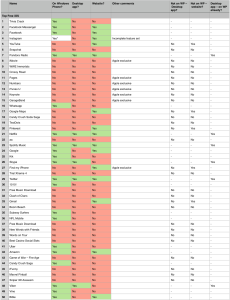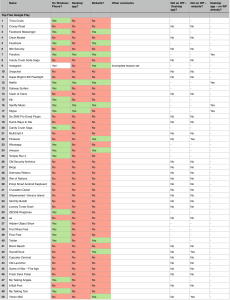Ahead of Microsoft’s next reveal of Windows 10 later this week, lots of blogs and news outlets are talking up the promise of the new operating system to unify the PC and mobile versions and in the process “solve the app gap”. Most of what I’ve read, though, seems to look straight past a huge flaw in this whole concept, one that I’ve talked about several times in other places (notably in my in-depth Windows Phone report from a few weeks back – available here for free). As such, I wanted to just quickly lay it out here for simplicity and clarity.
First, the theory: in Windows 10, Microsoft is creating a single operating system which will run across different form factors, with much of the underlying code shared and the rest tweaked by device type and size. This will allow developers to create apps which run 90% of the same code, with just some customizations for different device types and sizes. This, in turn, will allow Microsoft to tap into the vast number of Windows PC developers, who will now be able to port their apps to Windows Phone will very little additional work, which will drive a large number of new apps to the mobile platform, reducing the app gap relative to iOS and Android.
However, there’s a fundamental flaw in this argument, which is that the apps Windows Phone is missing simply don’t exist as desktop apps on Windows. Just think about it for a moment, and you’ll realize it’s empirically obvious: almost all the apps which are most popular on mobile are in one of these categories:
- Games, which dominate the app stores, and tend to be mobile-only in many cases
- Properties which exist as websites on the desktop and only exist as apps on the mobile side
- Properties which are mobile-first and/or mobile-only, such as Instagram, Vine, Viber and so on.
But we don’t need to rely on gut feel here – it’s very easy to do the analysis. I’ve pasted below two small thumbnails which you can click on to expand to full size. They show tables for the top free iOS and Android apps as of today, according to App Annie. Against each of the apps I’ve completed several more columns to reflect the following data:
- Is the app already in the Windows Phone store?
- Is there a desktop app on Windows (any version, not just Windows 8)?
- Is this an app which is actually a website rather than an app on the desktop?
I’ve then done some filters in the following columns to answer each of the following questions:
- Of those apps which are not on Windows Phone today, are these available for Windows PCs today?
- Of those apps which are not on Windows Phone today, are these available as a website on desktop?
- Of those apps for which there is a desktop app on Windows today, are these also available on Windows Phone?
You can go ahead and have a look at the tables to see the results for yourself (they should open in a new window or tab by default):
But here’s the summary:
- Among the top 50 free iOS and Android apps, there is not one which is not on Windows Phone but exists as a desktop app on Windows
- Among the top 50 free iOS and Android apps, there are a handful which exist as websites but not as desktop apps (almost all owned by either Google or Apple)
- All of the top 50 free iOS and Android apps for which there is a Windows desktop app already exist as Windows Phone apps today.
In other words, if the theory is that sharing a code base across desktop and mobile will lead to desktop apps being ported to the mobile environment in greater numbers, within this sample at least this has no applicability at all. All the apps available on Windows PCs are already available on Windows Phone. A handful of the rest exist as websites on the desktop, but the vast majority simply don’t exist today on any flavor of Windows.
There are two important caveats here. Firstly, this analysis only looks at the top 50 apps, and a different pattern could theoretically emerge if one were to examine a longer list of apps. However, from what I’ve seen the patterns are broadly similar, and the same conclusions would apply. Secondly, this analysis focuses on the most popular apps, which are naturally dominated by consumer-facing applications and not those used in the enterprise. I do believe that there are cases where desktop apps exist for enterprises but not yet for Windows Phone, and in this case the theory behind Windows 10 may well have at least some applicability. But that’s a far cry from saying that Windows 10 will help to solve the app gap, which is fundamentally a consumer problem, not an enterprise one.
Having said all this, I’m very curious to see what Microsoft has to say this week with regard to the mobile flavor of Windows 10 in particular. I think it’s getting a lot right in Windows 10 more generally, but the real solution to fixing Windows Phone lies in making the platform more compelling to consumers, and not just at the low end where it’s currently so focused.
For further reading on Windows and Windows Phone:
- The State of Windows Phone – summary of the in-depth report linked to above
- The Windows Phone app gap – an excerpt from the report, examining not just the much-ballyhooed “app gap” versus iOS and Android, but as importantly the “app lag”
- Windows 10 – Fixing the Windows 8 Mistake – my broader take on Windows 10 and its potential.
An archive of all my previous posts from this site on Microsoft is here.

